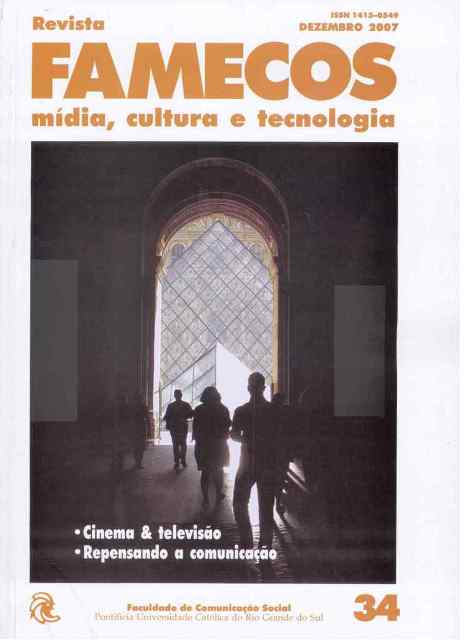Electronic media and an invitation to collaborate on artistic and cultural projects
DOI:
https://doi.org/10.15448/1980-3729.2007.34.3454Keywords:
Media, collaboration, technologyAbstract
This work proposes to show practices that use electronic media to assist in the process of collaboration in artistic and cultural projects. Projects that use the internet, cellular telephony, GPS, Wi-Fi networks, among other means, can mobilize a large number of people to collaborate, produce and have an active position. Also the purpose of this work is an invitation to collaboration, and many of these projects only work if people participate. Initiatives exist many, what is lacking is to create in the public an education for the activity. Electronic media enable and facilitate artistic and cultural creations, it is up to educators and cultural producers to develop skills and motivation to do so.Downloads
References
BAIGORRI, Laura. El futuro ya no es lo que era. De la Guerrilla Television a la Resistencia en la red. Aleph-arts, 1998. Disponível em: http://aleph-arts.org/pens/baigorri.html. Acesso em: nov. 2005.
BENKLER, Yochai. The Political Economy of Commons. Upgrade, 2003. Disponível em: http://www.benkler.org/Upgrade-Novatica%20Commons.pdf
GERE, Charlie. Digital culture. London: Reaktion Books, 2002.
HARDIN, Garrett. The Tragedy of the Commons. Science, 1968. Disponível em: http://www.garretthardinsociety.org/articles/art_tragedy_of_the_commons.html.
HELD, John. The Mail Art Exhibition: Personal Worlds to Cultural Strategies. In: CHANDLER, Annmarie; NEUMARK, Norie (Ed.). At a distance: precursors to art and activism on the Internet. Cambridge, Mass: MIT Press, 2005.
HIGGINS, Hannah. Fluxus experience. Berkeley: University of California Press, 2002.
LATOUR, Bruno. There is no information, only transformation. An Interview with Bruno Latour. In: LOVINK, Geert (Ed.). Uncanny networks: dialogues with the virtual intelligentsia. Cambridge, Mass: MIT Press, 2002.
LESSIG, Lawrence. The future of ideas: the fate of the commons in a connected world. New York: Random House. 2001.
LEVINSON, Paul. Digital McLuhan: a guide to the information millennium. London, New York: Routledge, 1999.
MANOVICH, Lev. The language of new media. Cambridge, Mass: MIT Press, 2002.
PERKINS, Stephen. Assembling Magazines and Alternative Artists' Network. In: CHANDLER, Annmarie; NEUMARK, Norie (Ed.). At a distance: precursors to art and activism on the Internet. Cambridge, Mass: MIT Press, 2005.
RIBEIRO, Ana Elisa. Os enciclopedistas franceses rolam nos túmulos. Digestivo Cultural, 2007. Disponível em: http://www.digestivocultural.com/colunistas/coluna.asp?codigo=2251.
ROSAS, Ricardo. The Revenge of Lowtech: Autolabs, Telecentros and Tactical Media in São Paulo. In: Sarai Reader. Delhi: Sarai Programme, CSDS, 2004.
SMITH, Owen F. Fluxus Praxis: An Exploration of Connections, Creativity, and Community. In: CHANDLER, Annmarie; NEUMARK, Norie (Ed.). At a distance: precursors to art and activism on the Internet. Cambridge, Mass: MIT Press, 2005.
TREND, David. The crisis of meaning in culture and education. Minneapolis: University of Minnesota Press, 1995.
TRIBE, Mark; JANA, Reena. Arte y nuevas tecnologías. Köln, Germany: Taschen, 2006.
VIRILIO, Paul. La grande optique. In: WEIBEL, Peter (Ed.). Zur Rechtfertigung der hypothetischen Natur der Kunst und der Nicht-Identität in der Objektwelt. Köln: Tanja Grunert, 2000.
Downloads
Published
How to Cite
Issue
Section
License
Copyright
The submission of originals to Revista Famecos implies the transfer by the authors of the right for publication. Authors retain copyright and grant the journal right of first publication. If the authors wish to include the same data into another publication, they must cite Revista Famecos as the site of original publication.
Creative Commons License
Except where otherwise specified, material published in this journal is licensed under a Creative Commons Attribution 4.0 International license, which allows unrestricted use, distribution and reproduction in any medium, provided the original publication is correctly cited.






